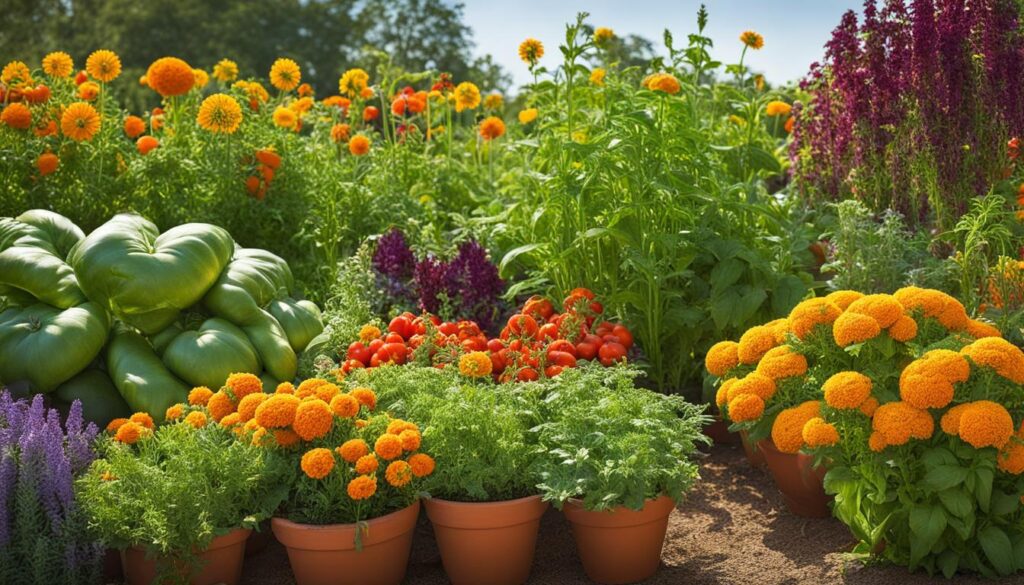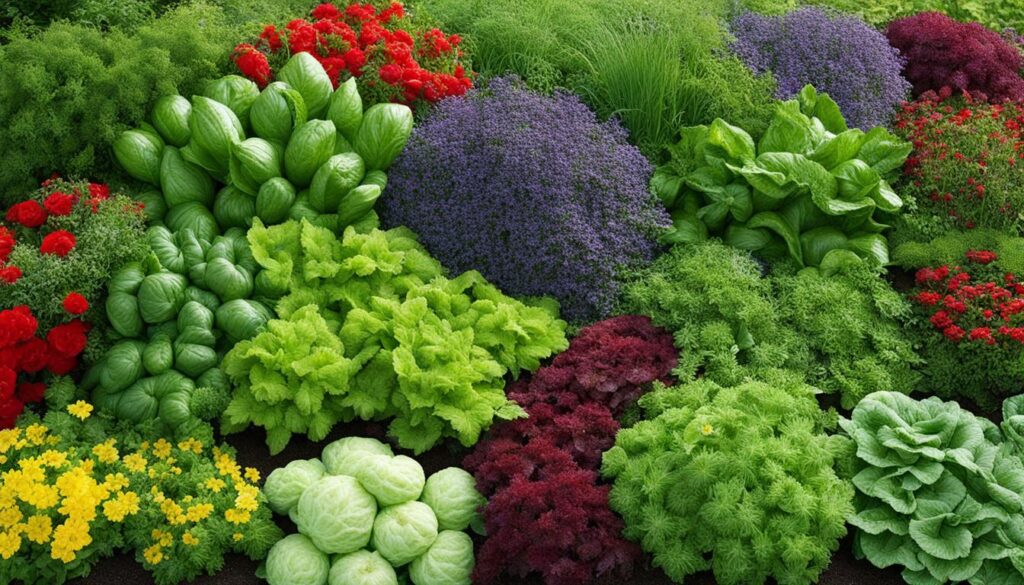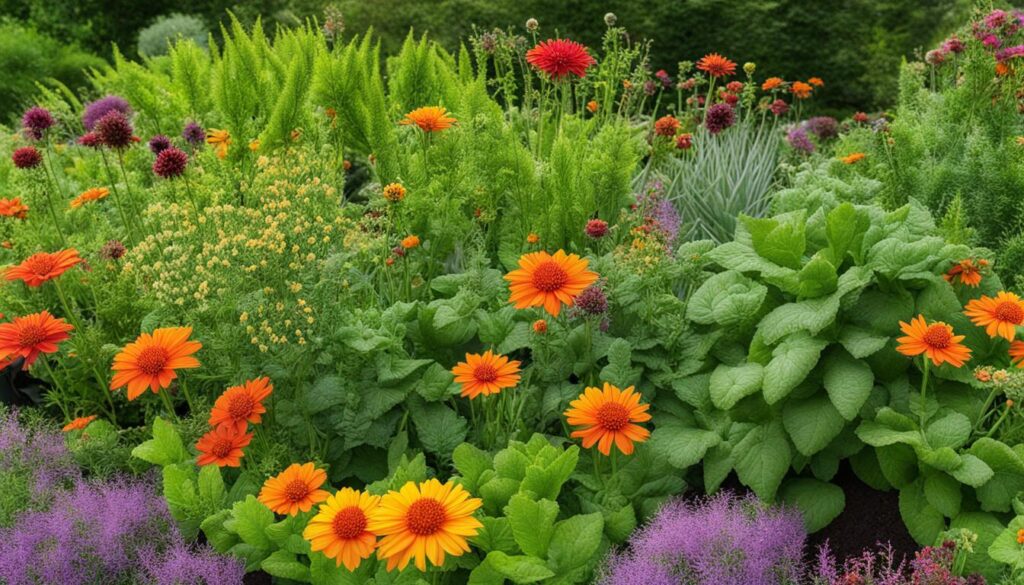Gardening enthusiasts, rejoice! I’m here to share with you the exciting world of companion planting and how it can unlock the power of your garden. Companion planting is a tried-and-true gardening technique that involves growing different plants together to maximize growth, enhance flavors, and repel pests naturally.
Companion planting isn’t just a trendy gardening buzzword – it’s a proven method that has been utilized by gardeners for centuries. By strategically pairing compatible plants, you can create a harmonious ecosystem that works in your favor, boosting growth and protecting your precious crops from harmful pests.
Key Takeaways:
- Companion planting is a gardening technique that involves growing different plants together to enhance crop production.
- It can optimize productivity, prevent pest infestations, and improve soil health.
- Some common benefits of companion planting include pest control, soil improvement, increased pollination, and space efficiency.
- There are various well-known companion planting combinations, such as the “three sisters” method and pairing tomatoes with marigolds and basil.
- Not all plant combinations work well together; it’s important to research and avoid incompatible companion planting combinations.
Benefits of Companion Planting
Companion planting is not just about growing multiple plants in close proximity; it offers a range of benefits that can greatly enhance your gardening experience. By strategically pairing plants, you can create a thriving and sustainable garden that is not only visually appealing but also productive and eco-friendly.
One of the main advantages of companion planting is pest control. Certain plant combinations have natural repellent properties that can help keep harmful insects at bay, reducing the need for chemical pesticides. For example, planting marigolds alongside tomatoes can deter nematodes, while the strong scent of basil can help repel mosquitoes and flies.
Companion planting also contributes to improved soil quality. Some plants, such as legumes like beans and peas, have the ability to fix nitrogen in the soil, enriching it naturally. This helps provide a steady supply of essential nutrients to neighboring plants. Additionally, plants like comfrey and nettles can be used as natural fertilizers, further nourishing the soil and promoting healthy growth.
Another benefit of companion planting is the attraction of pollinators. Flowers like borage, lavender, and sunflowers not only add beauty to your garden but also entice bees and other beneficial insects. These pollinators play a crucial role in fertilizing plants, leading to enhanced fruit and vegetable production.
Companion planting also maximizes space efficiency in your garden. By combining plants with different growth habits, you can utilize limited space to its full potential. For example, planting taller plants like corn or sunflowers alongside vining plants like cucumbers or beans provides natural support and allows for vertical growth, making the most of vertical space.
Additionally, certain companion plants can enhance the flavor of vegetables and herbs. For instance, planting dill near cucumbers not only helps repel pests but also imparts a subtle flavor to the cucumber fruit. The aromatic presence of herbs like thyme and oregano can also improve the taste of neighboring vegetables.
To summarize, the benefits of companion planting are numerous and impactful. It offers natural pest control, soil improvement, pollinator attraction, space optimization, and flavor enhancement. By embracing companion planting techniques, you can create a harmonious and thriving garden ecosystem that rewards you with healthy and abundant harvests.
| Benefits of Companion Planting | Description |
|---|---|
| Pest Control | Certain plant combinations repel harmful insects, reducing the need for pesticides. |
| Soil Improvement | Companion plants fix nitrogen and contribute natural fertilizers, enriching the soil. |
| Pollinator Attraction | Flowers attract bees and beneficial insects, aiding in pollination and fruit production. |
| Space Efficiency | Combining plants with different growth habits optimizes space usage in the garden. |
| Flavor Enhancement | Certain companion plants can enhance the taste of vegetables and herbs. |
Common Companion Planting Combinations
When it comes to companion planting, certain combinations have proven to be particularly effective in gardens. By strategically pairing plants, you can enhance their growth, deter pests, and boost overall productivity. Here are some common companion planting combinations to consider:
The Three Sisters
One popular combination method is called the “Three Sisters,” which involves planting corn, beans, and winter squash together. This symbiotic trio provides mutual benefits: the corn provides support for the beans to climb, while the beans fix nitrogen in the soil, benefiting both the corn and squash. The sprawling squash leaves help shade the ground and suppress weeds, creating a harmonious growing environment.
Cabbages and Aromatic Herbs
Planting cabbages with aromatic herbs like thyme, rosemary, or sage can help repel pests that commonly affect cabbages, such as cabbage worms and aphids. The strong scents of these herbs act as natural deterrents, preventing infestations and reducing the need for chemical pesticides. Plus, you’ll have fresh herbs at hand for culinary purposes!
Cucumbers and Radishes
Interplanting cucumbers and radishes can be highly beneficial for both crops. Radishes mature quickly and help break up compacted soil, making it easier for cucumber roots to access nutrients and water. Additionally, radishes act as natural pest repellents, deterring cucumber beetles and other pests that commonly plague cucumbers. This combination promotes healthier growth and higher yields for both plants.

Tomatoes, Marigolds, and Basil
The combination of tomatoes, marigolds, and basil creates a dynamic trio that benefits each plant. Marigolds serve as natural pest deterrents, repelling harmful insects like nematodes and aphids. Basil, when planted near tomatoes, can improve their flavor and repel tomato hornworms. This combination not only enhances the taste of tomatoes but also increases their resistance to pests, resulting in healthier plants and higher-quality produce.
These examples demonstrate the positive synergistic effects of companion planting. By experimenting with different combinations and observing the results in your own garden, you can unlock the power of companion planting to maximize growth, prevent pests, and create a thriving ecosystem.
Incompatible Companion Planting Combinations
In companion planting, not all plant combinations work harmoniously together. Some combinations can have negative interactions that hinder the growth and productivity of plants. It is crucial for gardeners to research and avoid incompatible companion planting combinations to ensure successful garden growth.
Here are a few examples of incompatible companion planting combinations:
- Potatoes and Tomatoes: Both potatoes and tomatoes belong to the nightshade family and have similar nutrient requirements. When planted together, they compete for nutrients in the soil, which can result in stunted growth and reduced yields for both plants.
- Strawberries and Cabbage Family: Planting strawberries near members of the cabbage family, such as cabbage, kale, or broccoli, can have a detrimental effect on each other’s growth. The cabbage family plants release compounds that inhibit strawberry growth, leading to lower yields.
- Onions and Beans: Onions and beans have different growing requirements. Onions prefer well-drained soil, while beans benefit from fertile, moisture-retentive soil. Planting onions and beans in close proximity can result in nutrient competition and hinder the growth of both plants.
- Cucumbers and Aromatic Herbs: Certain aromatic herbs, such as dill and sage, can stunt the growth of cucumbers and affect their flavor. It is best to avoid planting cucumbers near these herbs to ensure optimal cucumber growth and quality.
By avoiding these incompatible companion planting combinations, gardeners can prevent nutrient competition, growth inhibition, and reduced yields. Researching and carefully planning companion planting combinations can lead to successful and thriving gardens.

Remember:
“Incompatible companion planting combinations can hinder plant growth and reduce yields. By avoiding these combinations, gardeners can ensure the success of their companion planting strategies and create thriving gardens.
Maximizing Space and Soil Health with Companion Planting
In small or container gardens, maximizing space is essential. Companion planting provides a solution by allowing gardeners to optimize space usage while enhancing productivity. By interplanting smaller and larger plants, you can make the most out of limited garden space, ensuring every inch is utilized effectively.
But maximizing space isn’t the only benefit of companion planting. It also promotes soil health and alleviates compaction issues. Different plants with varied root systems work together to cultivate healthy soil. Taproot plants like carrots and radishes break up compacted soil, improving its structure and increasing water and nutrient absorption. On the other hand, deep-rooted plants like asparagus and watermelon can access nutrients from deeper soil layers, making them available to other companion plants.
Companion planting goes beyond enhancing soil health. It also contributes to weed suppression and attracts beneficial insects, creating a balanced and thriving garden ecosystem. Certain plant combinations can naturally suppress weed growth, reducing the need for extensive weeding. Additionally, companion plants can attract beneficial insects such as ladybugs and lacewings, which help control pest populations by consuming harmful insects.

Companion Planting for Soil Health and Space Maximization
Incorporating companion plants with diverse root structures helps improve soil health and maximize space. Here’s a table showcasing some common companion planting combinations and their benefits:
| Companion Plants | Benefit |
|---|---|
| Carrots and Radishes | Carrots loosen soil for radish growth, while radishes break up compacted soil. |
| Asparagus and Watermelon | Asparagus improves soil texture and nutrient availability for watermelon, while watermelon’s deep roots enhance water retention for asparagus. |
| Beans and Corn | Beans fix nitrogen in the soil, benefiting corn, while corn provides support for bean vines. |
| Basil and Tomatoes | Basil repels pests that commonly affect tomatoes, leading to healthier plants. |
By strategically selecting companion plants with complementary root systems and growth habits, you can achieve a flourishing garden that maximizes space and promotes soil health. Let companion planting be your secret weapon to a bountiful harvest and a vibrant garden ecosystem.
Insect Management through Companion Planting
Companion planting is not only beneficial for boosting growth and improving soil health, but it also offers a natural way to manage insect populations in the garden. By strategically selecting companion plants, gardeners can repel harmful pests and attract beneficial insects and pollinators, creating a balanced and thriving ecosystem.
The scents and colors of certain herbs and flowers act as natural repellents for pests. For example, planting marigolds alongside vegetables can repel aphids, nematodes, and whiteflies. Similarly, the strong scent of garlic can deter pests like aphids, caterpillars, and Japanese beetles. These companion plants act as a barrier, protecting the main crops from potential infestations.
Additionally, trap cropping can be utilized as an effective insect management technique. By planting a sacrificial crop that is particularly attractive to pests, such as sunflowers for aphids or radishes for flea beetles, gardeners can divert the attention of pests away from the main crops. This diversion tactic not only helps control pest populations but also helps safeguard the health and productivity of the desired plants.
Insect management through companion planting is not limited to pest repulsion. It also involves attracting beneficial insects and pollinators to the garden. Brightly colored flowers like zinnias, cosmos, and sunflowers act as magnets for beneficial insects such as ladybugs, lacewings, and hoverflies, which prey on harmful pests. These companion plants attract the right allies, creating a natural defense system against unwanted insects.
Moreover, specific plant choices can enhance the overall ecosystem balance in the garden. For instance, planting dill, fennel, or parsley can attract beneficial insects like bees and wasps, ensuring proper pollination and a healthy garden. By including a variety of companion plants with different functions, gardeners can create a diverse and vibrant habitat that supports the well-being of both plants and insects.

Companion planting provides a holistic approach to insect management, addressing both pest control and the promotion of beneficial insects. By leveraging the power of companion plants, gardeners can naturally manage insect populations while minimizing the use of harmful pesticides and preserving the health and diversity of their gardens.
The Art of Companion Planting
Companion planting is not an exact science, but rather an art that requires observation and experimentation. Successful companion planting can vary depending on the specific location and climate.
When starting your companion planting journey, it is recommended to consult companion planting charts as a starting point. These charts provide valuable information on compatible plant combinations and help you make informed decisions.
However, it is important to keep in mind that not all companion planting combinations work the same way in every garden. Each garden has its unique microclimate and soil conditions. Therefore, it is crucial to keep a record of your personal observations and results from different plant combinations over time.
Keeping a gardening journal allows you to track the performance of different plant combinations and learn which combinations work best for your specific garden. You can document the growth rates, pest resistance, and overall health of your plants to make adjustments and improve your companion planting strategies.
This knowledge is not only beneficial for your own gardening ventures but can also be shared with other gardeners to promote education and assist in developing successful companion planting strategies.
In addition to consulting charts and maintaining a gardening journal, it can be helpful to reach out to your local extension office or gardening community. These resources often provide valuable guidance and suggestions for compatible companion crops based on the specific conditions of your region.
Remember, companion planting is an art that offers endless possibilities. By experimenting with different plant combinations and leveraging the collective knowledge of the gardening community, you can unlock the full potential of companion planting and create a beautiful and bountiful garden.
Maximizing Companion Planting in Square Foot Gardens
Square foot gardening, a method of gardening in small spaces, can greatly benefit from companion planting. By utilizing companion planting techniques, square foot gardeners can further enhance crop production, improve flavor, and protect plants.
The close proximity of plants in a square foot garden creates a conducive environment for companion planting. Gardeners can follow companion planting charts and consider the specific needs and compatibility of plants when planning their square foot gardens.
Companion planting adds diversity and beauty to square foot gardens while maximizing the use of limited space. It not only allows for the efficient use of resources but also promotes a natural balance within the garden ecosystem.
“Square foot gardening provides a unique opportunity to explore the benefits of companion planting. By strategically pairing plants, gardeners can create a harmonious microenvironment that encourages growth, discourages pests, and fosters healthy crop development.”
Conclusion
I hope this article has helped you unlock the power of companion planting and understand its potential for boosting growth and repelling pests in your garden. By strategically pairing compatible plants, you can create a harmonious ecosystem that optimizes space, improves soil health, and naturally manages insect populations.
Companion planting is not a one-size-fits-all approach. It requires careful research, observation, and experimentation to find the best combinations for your specific garden and climate. Keep in mind that successful companion planting is an art that evolves over time as you learn from your own experiences.
Whether you have a traditional garden or a square foot garden, companion planting offers a wide range of benefits. From increasing crop yields to enhancing flavor and attracting beneficial insects, this technique can transform your green space into a thriving and productive oasis.
So why not give companion planting a try? Unlock the power of companion planting in your garden and unleash its potential to create a vibrant and bountiful environment, where plants work together to achieve growth and repel pests naturally.
FAQ
What is companion planting?
Companion planting is a gardening technique that involves growing different plants together to enhance crop production.
What are the benefits of companion planting?
Companion planting offers a variety of benefits including pest control, improved soil quality, attracting pollinators, increased space efficiency, and enhanced flavor of certain vegetables and herbs.
Can you provide some examples of common companion planting combinations?
Yes, examples include the “three sisters” method (corn, beans, and winter squash), cabbages with aromatic herbs, cucumbers and radishes, and tomatoes with marigolds and basil.
Are there any incompatible companion planting combinations to avoid?
Yes, some examples include planting potatoes and tomatoes together, strawberries and members of the cabbage family, onions and beans, and cucumbers with certain aromatic herbs.
How does companion planting maximize space and improve soil health?
Companion planting optimizes space usage by interplanting smaller and larger plants and improves soil health by utilizing plants with different root systems to break up compacted soil and access nutrients from different soil layers.
Can companion planting help manage insect populations in the garden?
Yes, certain plant combinations can repel harmful insects, attract beneficial insects, and help maintain a balanced ecosystem in the garden.
How can I become successful at companion planting?
Successful companion planting requires research, observation, and experimentation. It is recommended to consult companion planting charts, keep records of personal observations, and seek guidance from local extension offices.
Can companion planting be used in square foot gardens?
Yes, companion planting can greatly benefit square foot gardens by further enhancing crop production, improving flavor, and protecting plants. Its close proximity creates an ideal environment for companion planting.
In conclusion, what are the advantages of companion planting?
Companion planting harnesses the power of plant combinations to boost growth and repel pests, enhancing crop yields, maximizing space usage, improving soil health, and managing insect populations naturally.


[…] Sturdy foundation for plant growth […]
[…] the blissful experience they offer. Enhance your self-care routine with natural bath tea blends and unlock the healing power of […]
[…] can boost your self-care routine and embrace a new level of well-being. Discover the transformative power of a mindful beauty journey and unlock your true […]
[…] Unlock the power of homemade herbal teas and embrace a holistic approach to wellness. Let nature’s remedies nourish and uplift you on your journey towards a healthier, more vibrant life. […]
[…] inner glow starts in your kitchen. By choosing fresh and natural foods, you are giving your body a powerful boost of vitamins, minerals, and antioxidants that promote healthy skin, hair, and nails. Here are some […]